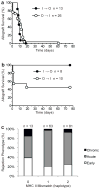Allograft outcomes in outbred mice
- PMID: 23311531
- PMCID: PMC3582712
- DOI: 10.1111/ajt.12056
Allograft outcomes in outbred mice
Abstract
Inbreeding depression and lack of genetic diversity in inbred mice could mask unappreciated causes of graft failure or remove barriers to tolerance induction. To test these possibilities, we performed heart transplantation between outbred or inbred mice. Unlike untreated inbred mice in which all allografts were rejected acutely (6-16 days posttransplantation), untreated outbred mice had heterogeneous outcomes, with grafts failing early (<4 days posttransplantation), acutely (6-24 days) or undergoing chronic rejection (>75 days). Blocking T cell costimulation induced long-term graft acceptance in both inbred and outbred mice, but did not prevent the early graft failure observed in the latter. Further investigation of this early phenotype established that it is dependent on the donor, and not the recipient, being outbred and that it is characterized by hemorrhagic necrosis and neutrophilic vasculitis in the graft without preformed, high titer antidonor antibodies in the recipient. Complement or neutrophil depletion prevented early failure of outbred grafts, whereas transplanting CD73-deficient inbred hearts, which are highly susceptible to ischemia-reperfusion injury, recapitulated the early phenotype. Therefore, outbred mice could provide broader insight into donor and recipient determinants of allograft outcomes but their hybrid vigor and genetic diversity do not constitute a uniform barrier to tolerance induction.
© Copyright 2013 The American Society of Transplantation and the American Society of Transplant Surgeons.
Conflict of interest statement
The authors of this manuscript have no conflicts of interest to disclose as described by the
Figures





Similar articles
-
Host CD40 ligand deficiency induces long-term allograft survival and donor-specific tolerance in mouse cardiac transplantation but does not prevent graft arteriosclerosis.J Immunol. 2000 Sep 15;165(6):3506-18. doi: 10.4049/jimmunol.165.6.3506. J Immunol. 2000. PMID: 10975872
-
Spontaneous allograft tolerance in B7-deficient mice independent of preexisting endogenous CD4+CD25+ regulatory T-cells.Transplantation. 2007 Jun 15;83(11):1449-58. doi: 10.1097/01.tp.0000265482.88936.b1. Transplantation. 2007. PMID: 17565318 Free PMC article.
-
Induction of Major Histocompatibility Complex-mismatched Mouse Lung Allograft Acceptance With Combined Donor Bone Marrow: Lung Transplant Using a 12-Hour Nonmyeloablative Conditioning Regimen.Transplantation. 2016 Dec;100(12):e140-e146. doi: 10.1097/TP.0000000000001480. Transplantation. 2016. PMID: 27861294 Free PMC article.
-
Assessment of peripheral tolerance in anti-CD4 treated C57BL/6 mouse heart transplants recipients.Transpl Immunol. 1999 Mar;7(1):37-44. doi: 10.1016/s0966-3274(99)80017-3. Transpl Immunol. 1999. PMID: 10375076
-
Combined Anti-CD154/CTLA4Ig Costimulation Blockade-Based Therapy Induces Donor-Specific Tolerance to Vascularized Osteomyocutaneous Allografts.Am J Transplant. 2016 Jul;16(7):2030-41. doi: 10.1111/ajt.13694. Epub 2016 Feb 23. Am J Transplant. 2016. PMID: 26914847
Cited by
-
Preventing the rejection of skin allografts by immunomodulatory and regenerative effects of exosomes derived from bone marrow mesenchymal stem cells in mice.Iran J Basic Med Sci. 2025;28(4):469-476. doi: 10.22038/ijbms.2025.82564.17841. Iran J Basic Med Sci. 2025. PMID: 39968091 Free PMC article.
-
Suppression of progesterone by influenza A virus mediates adverse maternal and fetal outcomes in mice.mBio. 2024 Feb 14;15(2):e0306523. doi: 10.1128/mbio.03065-23. Epub 2024 Jan 8. mBio. 2024. PMID: 38190129 Free PMC article.
-
Induction of liver transplant immune tolerance in an outbred rat strain model using tacrolimus.Lab Anim Res. 2023 Mar 8;39(1):5. doi: 10.1186/s42826-023-00156-5. Lab Anim Res. 2023. PMID: 36890604 Free PMC article.
-
Genomic, microbial and environmental standardization in animal experimentation limiting immunological discovery.BMC Immunol. 2020 Sep 2;21(1):50. doi: 10.1186/s12865-020-00380-x. BMC Immunol. 2020. PMID: 32878597 Free PMC article. Review.
-
Preservation solutions for attenuation of ischemia-reperfusion injury in vascularized composite allotransplantation.SAGE Open Med. 2021 Jul 21;9:20503121211034924. doi: 10.1177/20503121211034924. eCollection 2021. SAGE Open Med. 2021. PMID: 34367640 Free PMC article.
References
-
- Charlesworth B, Charlesworth D. The genetic basis of inbreeding depression. Genet Res. 1999;74:329–340. - PubMed
-
- Frankham R. Conservation genetics. Annu Rev Genet. 1995;29:305–327. - PubMed
-
- Beck JA, Lloyd S, Hafezparast M, Lennon-Pierce M, Eppig JT, Festing MF, et al. Genealogies of mouse inbred strains. Nat Genet. 2000;24:23–25. - PubMed
Publication types
MeSH terms
Grants and funding
LinkOut - more resources
Full Text Sources
Other Literature Sources
Medical
Research Materials

